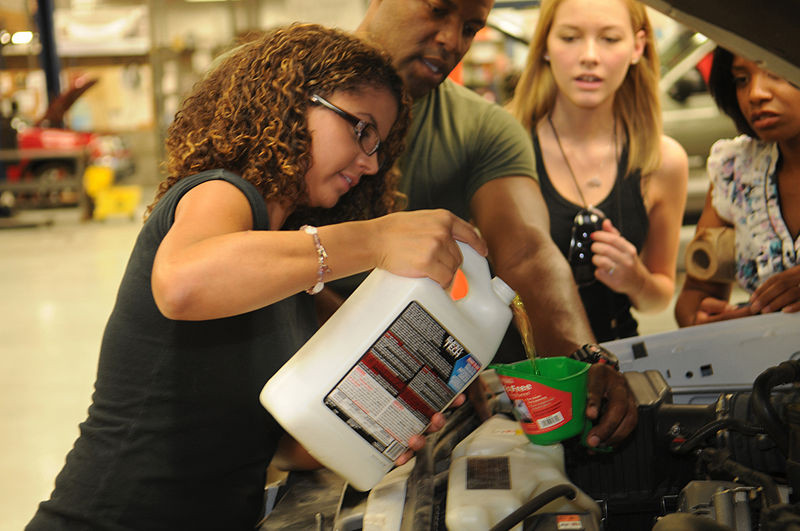Your car’s engine should maintain an optimal temperature at all times. Along with relying on a host of important parts to keep it running, the engine significantly depends on its water pump to help it keep at a temperature that allows for top performance without overheating.

Keeping the cooling sysytem in check is of utmost importance to keep the engine from overheating. Photo by United States Marine Corps. CC0 1.0 Public Domain.
The water pump is such an important key to your engine’s cooling system that the engine could suffer from serious damage in case of failure. You can prevent this damage and keep your car’s engine running smoothly by knowing what signs to look for.
The Cooling System is Essential for the Longevity of the Engine
The cooling system is responsible for cycling the coolant from the radiator throughout the entire engine. The coolant absorbs the heat from the engine and is cycled back to the radiator where it is once again cooled. We have covered this topic earlier, and you can find out more about this particular process here.
Water Pump Failure is Often Discovered when the Damage is already Done
The water pump, which is operated by the drive belt, plays an important role in the cooling system. As the drive belt turns, so does the water pump, and it cycles the coolant through the system. The typical water pump can last anywhere from 90,000 to 120,000 miles before it needs to be replaced. However, a number of different factors can contribute to the need for early replacement.
While it is important to know the warning signs of water pump failure, it is just as important that you act quickly and protect your engine before the onset of massive damage. Many times, people realize what’s happening too late to stop such damages. They only discover that the water pump is not working when the damage has already been done.

Photo by Maly LOLek / Wikimedia Commons / CC BY-SA 3.0 / GNU FDL 1.2
Such a scenario can be avoided by knowing what to look for; signs that could indicate that your water pump is about to fail. The most common symptom includes a high engine temperature reading. When the temperature gauge goes well past its normal range, check the water pump first. Turn off the engine to avoid any further damages from occurring.
Another sign includes seeing puddles of coolant under your car. Coolant leaks are a pretty solid indication the water pump is damaged. Don’t think for a second that you have the luxury of waiting until the high temperature warning lights up: if you wait, or even ignore the light, you will most definitely have to pay for much more expensive and lengthy repairs.
But what exactly causes such damages to the water pump in the first place? Well, a number of different factors contribute to its malfunction. You can act in your car’s best interest by learning more about these causes and what symptoms accompany each.
Checking for the following issues will help you spot water pump issues in time:
1. Rust and Corrosion: Rust and corrosion are found on the top of a damaged water pump. The impeller fins of the pump stop working and the pump is not able to move the coolant in the engine. Rust and corrosion can be caused by contaminated or poor quality coolant as well as a defective pressure cap that causes air bubbles. Before you replace the water pump, the entire cooling system must be flushed and the pressure cap replaced with one recommended by the manufacturer of the car.
2. Deposit Buildup: Deposit buildup is also caused by poor quality or contaminated coolant. It causes the formation of sludge, scale, and other deposits on the inside of the water pump, which can then interfere with its proper function. If that happens, the cooling system will need a flush and a refill with a recommended high-quality coolant before the water pump can be replaced.
3. Cavitation: Vapor cavities, or bubbles, in the coolant can cause pressure in the pump and cause damage to the pump’s components. Flushing out the cooling system and refilling it with new coolant before replacing the water pump is the only solution to this problem.
4. Leakage from the Mounting Surface: Bleeds, seeping, and drips indicate leakage from the pump’s mounting surface. This problem is typically caused by improper installation or the improper use of sealants, gaskets, and other parts. You can remedy it by carefully inspecting the water pump and readjusting it. If there’s more leakage, the pump needs to be replaced entirely. You also should replace the gaskets and seals to prevent seeps, drips, and bleeds.
5. Weep Hole Leakage: While some weep hole leakage is normal after a new pump is installed, it should not continue after more than 10 minutes. If it does, the cooling system may contain contaminated or poor quality coolant. You must flush out the system and refill it with fresh coolant before replacing the pump.
6. Damaged Bearings: Damage to the bearings is caused by a defective drive belt. Replace the belt system before putting in a new water pump.
7. Damaged or Broken Shaft: The shaft is damaged or broken because there is too much tension in the drive belt. This delivers too much force onto the shafts, causing them to break or sustain extensive damage. To remedy, you should inspect the belt system and replace pulleys, tensioners, and the belt itself before putting in a new water pump.
Water pump failure can inflict extensive damage to your car’s engine. Many people learn too late that their water pump has failed. By knowing what signs to look for, you can prevent extensive damage and limit the costs to changing an ill-performing water pump only.
The post Signs of Water Pump Failure appeared first on Proctor Cars Magazine.
